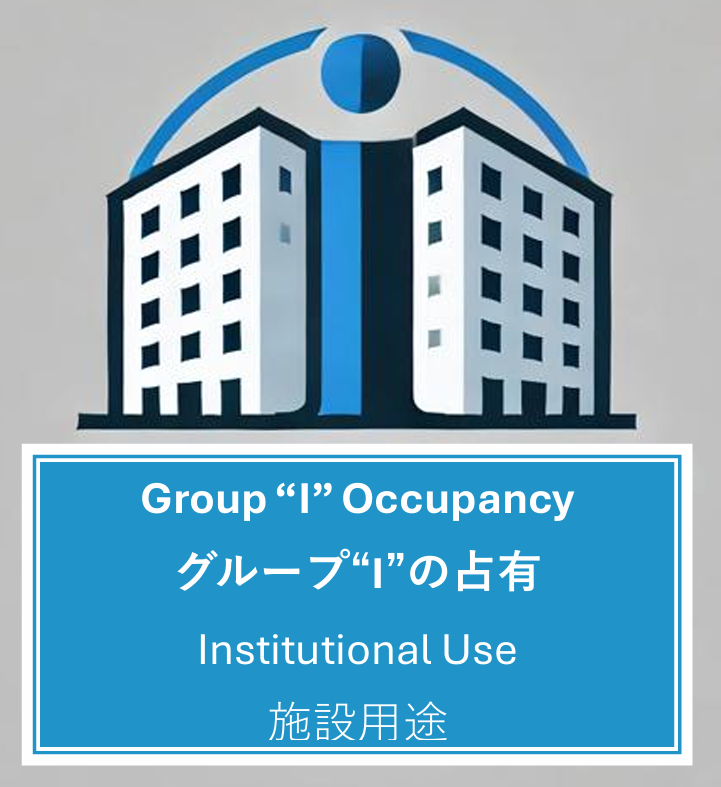
General Definition
- Institutional Group “I” Occupancy includes buildings where people are cared for, detained, or restricted in their movement due to medical conditions, age, disabilities, or legal confinement.
- The International Building Code (IBC) classifies institutional buildings based on occupant supervision, medical needs, and security levels, and are grouped under I-1, I-1, 1-3 & I-4 occupancies.
- In Japan’s Building Standards Law (BSL), there is no direct “Institutional” category equivalent to IBC group I occupancy.
- Instead, these facilities are classified under 福祉施設 (Fukushi Shisetsu) – Welfare Facilities and 寄宿舎 (Kishukusha) – Dormitory-Type Residences, etc., and regulated based on their function, resident needs, and fire safety considerations.
- BSL emphasizes strict fireproofing, seismic stability, and emergency preparedness due to Japan’s urban density and earthquake risks.
- Instead, these facilities are classified under 福祉施設 (Fukushi Shisetsu) – Welfare Facilities and 寄宿舎 (Kishukusha) – Dormitory-Type Residences, etc., and regulated based on their function, resident needs, and fire safety considerations.
IBC Institutional Group I-1 Occupancy
- Alcohol and drug centers
- Assisted living facilities
- Congregate care facilities
- Group homes
- Halfway houses
- Residential board and care facilities
BSL Occupancies Corresponding to IBC Group I-1
- 福祉施設 (Fukushi Shisetsu) – Welfare and Social Service Facilities
- 介護付き有料老人ホーム (Kaigo-tsuki Yūryō Rōjin Hōmu) – Assisted Living Facilities with Nursing Care
- 共同住宅型福祉施設 (Kyōdō Jūtaku-gata Fukushi Shisetsu) – Congregate Care Housing
- 更生施設 (Kōsei Shisetsu) – Halfway Houses (Rehabilitation and Reintegration Centers)
- 寄宿舎 (Kishukusha) – Dormitory-Type Residences
Click the button below to access the applicable codes guidelines:
Institutional Group I-2 Occupancy
- Foster care facilities
- Detoxification facilities
- Hospitals
- Nursing homes
- Psychiatric hospital
BSL Occupancies Corresponding to IBC Group I-2
- 病院 (Byōin) – Hospitals
- 精神科病院 (Seishin-ka Byōin) – Psychiatric Hospitals
- 特別養護老人ホーム (Tokubetsu Yōgo Rōjin Hōmu) – Special Elderly Nursing Homes
- 介護療養型医療施設 (Kaigo Ryōyō-gata Iryō Shisetsu) – Medical Care Facilities for Long-Term Patients
- 児童養護施設 (Jidō Yōgo Shisetsu) – Foster Care Facilities
- 依存症治療施設 (Izonshō Chiryo Shisetsu) – Detoxification and Rehabilitation Facilities
Click the button below to access the applicable codes guidelines:
IBC Institutional Group I-3 Occupancy
- Correctional centers
- Detention centers
- Jails
- Prerelease centers
- Prisons
- Reformatories
BSL Occupancies Corresponding to IBC Group I-3
- 刑務所 (Keimusho) – Prisons
- 拘置所 (Kōchisho) – Detention Centers
- 少年院 (Shōnen-in) – Reformatories (Juvenile Detention Centers)
- 更生施設 (Kōsei Shisetsu) – Prerelease Centers
- 入国管理センター (Nyūkoku Kanri Sentā) – Immigration Detention Centers
Click the button below to access applicable codes guidelines:
IBC Institutional Group I-4 Occupancy
- Adult day care
- Child day care
BSL Occupancies Corresponding to IBC Group I-4
- 認可保育所 (Ninka Hoikusho) – Licensed Child Day Care Centers
- 小規模保育施設 (Shōkibo Hoiku Shisetsu) – Small-Scale Child Day Care Facilities
- 幼稚園 (Yōchien) – Kindergartens (When Classified as Day Care Rather Than Educational)
- 高齢者デイサービスセンター (Kōreisha Dei Sābisu Sentā) – Elderly Day Service Centers
- 障害者デイケア施設 (Shōgaisha Dei Kea Shisetsu) – Disabled Persons Day Care Centers
Click the button below to access applicable codes guidelines:
Key Differences:
- IBC uses I-1 to I-4 categories to distinguish between medical care, assisted living, correctional facilities, and daycare centers.
- BSL categorizes institutional facilities based on function, with stricter seismic, fireproofing, and emergency response requirements for vulnerable populations.
- Daycare centers and assisted living facilities are treated differently in BSL, with separate classifications for young children, elderly residents, and medical patients.
